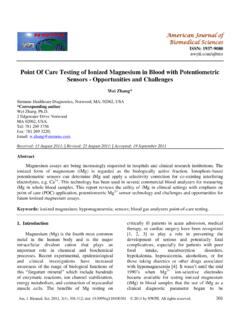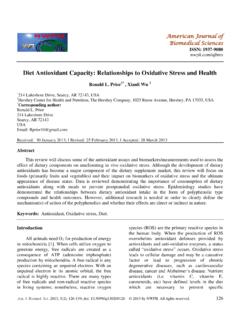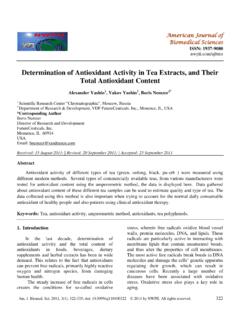Transcription of Recent Advances in Nanoparticles-based Lateral ... …
1 Am. J. Biomed. Sci. 2014, 6(1), 41-57; doi: 2014 by NWPII. All rights reserved 41 American Journal of Biomedical Sciences ISSN: 1937-9080 Recent Advances in Nanoparticles-based Lateral Flow Biosensors Xuefei Gao1, Li-Ping Xu1*, Shu-Feng Zhou2, Guodong Liu3, Xueji Zhang1* 1 Research center for Bioengineering and Sensing Technology, University of Science & Technology Beijing, Beijing, P. R. China 2 Department of Pharmaceutical Sciences, College of Pharmacy, University of South Florida, FL, USA 3 Department of Chemistry and Biochemistry, North Dakota State University, Fargo, ND, USA *Corresponding Author Dr Li-Ping Xu Research center for Bioengineering and Sensing Technology University of Science & Technology Beijing Beijing, 100083 P.
2 R. China Tel.: +86 10-8237-6831 E-mail: Dr Xueji Zhang Research center for Bioengineering and Sensing Technology University of Science & Technology Beijing Beijing, 100083 P. R. China Tel.: +86 10-8237-6993 E-mail: Received: 4 March 2014; | Revised: 18 March 2014; | Accepted: 26 March 2014 Abstract Lateral flow biosensors (LFBs) provide advantages in low cost, simplicity, rapidity, stability and portability, thus making LFBs popular in biomedical, agriculture, food and environmental sciences. This article reviews Recent Advances of LFBs for bioassays, including the investigation of the improvements achieved by signal-amplification strategies, the application of new nanoparticle labels, novel quantitative system and simultaneous detection.
3 We summarized the outstanding performances of LFBs such as high detection sensitivity, specificity, reproducibility and reliability. Keywords: Lateral flow biosensor, point-of-care testing, nanoparticles , bioassays 1. Introduction In the last decades, the detecting of biothreat agents, chemical contaminants and biomolecules has attracted much attention and various new methods including real-time polymerase chain reaction (RT-PCR) [1-4], DNA microarrays [5-8], enzyme linked immunosorbent assay (ELISA) [9-13], HPLC-MS [14-17] and immunosensor Am. J. Biomed. Sci. 2014, 6(1), 41-57; doi: 2014 by NWPII.
4 All rights reserved 42 techniques [18-23] have been employed. These methods offer high accuracy, but often require time-consuming sample pretreatment, technical expertise, sophisticated and expensive instrumentation, which are inappropriate for point-of-care testing and home testing. Lateral flow biosensors (LFBs), as a promising tool for detecting analyte, have recently attracted considerable interest because of their speed, simplicity, sensitivity, specificity, easy handling, and can potentially provide instantaneous diagnosis near the patients [24-33].
5 Originally the LFBs was used in human chorionic gonadotrophin (HCG) immunoassay and called sol particle immunoassay (SPIA) [34,35]. Since then, the LFB was widely applied in environmental monitoring, food safety, and clinical diagnosis for visual (qualitative) and quantitative detecting of various biomolecules and chemical contaminants such as infectious agents [36-41], nucleic acids [42,30,43], proteins [44,33], cells [28], veterinary drugs [45-50], toxins [51-56] and pesticides [57,58]. The principle of LFBs is based on a solid-phase chromatographic test strip containing dry reagents those are activated by applying the fluid sample.
6 Antibodies are immobilized on different positions of the LFB to capture target antigens and the colored detector reagents labeled on antibodies give the colored responses on the test zone and control zone on the LFB. The characteristic colored bands enable visual detection of target analyte without instrumentation. For quantitative measurements, the optical intensities of the test zone and control zone could be recorded simultaneously by corresponding instrumentation [59,60]. The aim of this article is to review major Advances in Recent years in LFB development and to compare the currently evaluated LFB with the traditional LFB.
7 New strategies from these studies were presented and discussed including: 1. investigation of the improvements achieved by signal-amplification strategies; 2. application of new nanoparticle labels; 3. introducing of novel quantitative system; 4. simultaneous detection of multiple analytes. 2. LFB assay formats and principle The LFB are designed to test the absence or presence of target analyte. The analyte might be the pathogens, hormones, drugs or metabolites. A specific labeled-antigen or labeled-antibody to the analyte is used for recognition. The LFB consists of four sections: sample application pad, conjugate pad, membrane and absorption pad.
8 All of the components are laminated on a common sheet of plastic adhesive backing orderly using the clamshell laminator. Each pad overlaps 2 mm to allow the migration of sample solution along the LFB during the analysis. Various possible formats have been described for LFBs, which are depending on the types of target analytes. The competitive assay and sandwich assay are the two most frequently used formats. When the target analyte is with low molecular weight or presenting single specific antigen, it is suitable for employing competitive format [61,62,48].
9 There are two approached based on the competitive format: 1) the specific antibody is firstly dispensed on the test zone. After applying the sample solution (containing the target antigen and the labeled antigen) to the sample application pad, the target antigen and labeled antigen would compete for binding on the specific antibody, which is immobilized on the test zone; 2) the sample solution containing target antigen is firstly incubated with the specific antibody to form the antigen-antibody complex. The antigen-antibody complex and labeled antibody would compete for binding on the specific antigen-protein conjugate, which is immobilized on the test zone [63].
10 As shown in Figure 1, in a typical competitive format, a monoclonal antibody (specific to target analyte-progesterone) immobilized on the test zone of a nitrocellulose (NC) membrane captures a colored reagent labeled analyte conjugate (progesterone-ovalbumin/GNPs conjugate), enabling colored reagent (colloidal gold nanoparticles (GNPs)) to accumulate on the test zone and form a characteristic red line on the test zone. The control line was immobilized by another specific protein to capture the excess colored reagent labeled conjugate.


